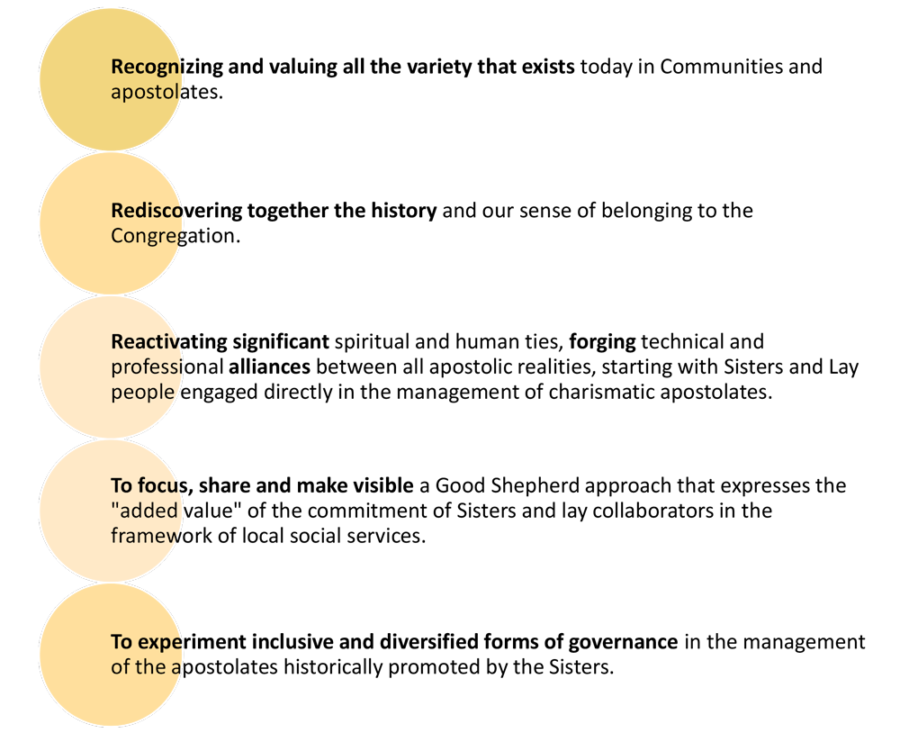Spirituality Spiritual growth at the heart of the strategic plan
“A spirituality that does not lead to strategies does not fulfill its goal. A strategy that is not based in a spirituality will fall short of the mark. There must be this mutual interaction. In that interaction it is the spirituality that should guide the strategy, even as the strategy gives the spirituality form in action and practice.”
Robert J. Schreiter, The Ministry of Reconciliation. Spirituality and strategies, 1998
Spiritual growth fosters personal and institutional resilience processes that, with the language of the heart (St John Eudes), we could call paths of reconciliation:

Today we can find an echo of our Mission in two biblical characters:
SIMEON

A just and pious man in deep intimacy with the Holy Spirit, who spoke to him and was “moved by the Spirit” and for this reason he was capable of:

ELEAZAR

Already in his later years, he chose to bear witness until the end to his loyalty in respect and adherence to the Word of God “I shall shew myself worthy of my old age: And I shall leave an example of fortitude to young men”. (2 Maccabees 18-31).
Today, through the Italy-Malta Strategic Plan, we too, like Eleazar, ask the grace of Constancy in living our values even in trials. Loyalty and responsibility towards ourselves and others Testimony for the younger generations… of Sisters and lay people attracted by the Charism of St John Eudes and St Mary Euphrasia.
The perspective of the human and spiritual growth of Sisters and Lay people as a special factor in the strategic plan of the IM Unit is therefore a fruitful perspective both to fully embrace the Magisterium of the Church and as a way to be followed by everyone; at every age, condition and status; open to both consecrated and lay people: a concrete way not to be afraid of weakness and fragility, for a “spiritual growth that goes hand in hand with the progressive integration of our human and spiritual dimension (Const. 54) in every condition and phase of life” according to the “principle of becoming in spiritual life” and the primacy of the heart lived in daily life, proper to the original charism.
“God dwells where he is allowed to enter. But we can only let Him in where we are, where we really are, where we live, and where we live an authentic life. If we establish a holy relationship with the small world that is entrusted to us, if, with creation around us, we help the holy spiritual essence to come to completion. Then we prepare a dwelling place for God in our place, then we let God enter.”
(see Strategic Plan Document – work in progress in May 2017).
Precisely the condition of need, of weakness that often characterizes the Third, Fourth and Fifth ages, can paradoxically become the blessed way to open up to co-responsibility with those lay people, young and old, who, attracted by the charism of St John Eudes and St Mary Euphrasia, together with the Sisters, nourish the dream of a reconciled world and relaunch the prophecy of the Founders. The theological category of the “remnant” is reaffirmed as a spiritual dimension, to be cultivated in a personal, communal and social form. Even today, in fact, as in the times of St Mary Euphrasia, the unheard of seems to be embodied in the ability to recognize and reconcile with the “other” which is the very opposite of a society of indifference, walls and non-integration.
When I am weak, then I am strong
Putting into practice what Jesus asks is a matter of grace rather than duty
Thus Cardinal Martini pointed to the need to integrate spirituality and the human sciences and, above all, to live according to the primacy of the language of the heart: “Create in me a pure heart, O God” (Psalm 51:10).
“The Gospel message cannot be reduced to something purely sociological. Rather, it is a spiritual guideline that is always new. It requires open-mindedness to imagine prophetic and charismatic ways to live Christian Discipleship through suitable, and possibly unprecedented, frameworks”.
(see New wine in new wineskins and Evangelii Gaudium 237).
